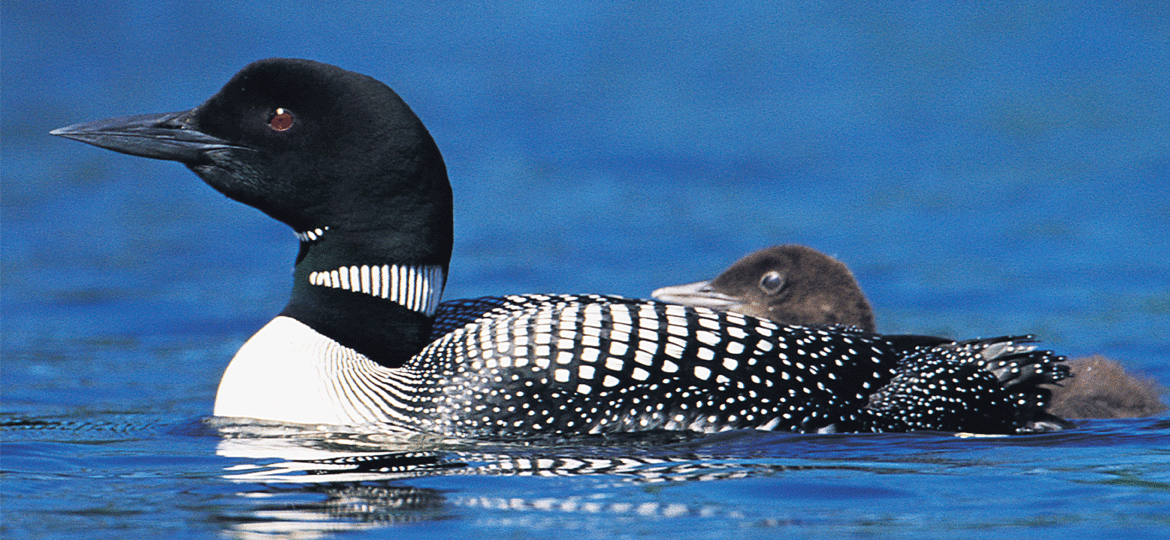
Birds resembling loons first evolved 130 million years ago. This primitive bird has since become a symbol of grace, beauty, and wildness for many people. Native Americans believed it was "The Spirit of the Northern Waters," and the French named it "The Diver with the Necklace."
Of the four species of loons found in North America, the Common Loon is the only breeding species in Vermont. Loons are sensitive to disturbances, especially during the breeding season. People are encouraged to remain at least 300 feet from nesting and nursery areas during this period.
Habitat
Loons breed on lakes and deep ponds. They nest close to shorelines or on small islands. The nest is a simple pile of vegetation or a small depression in the soil and in it is laid one or two eggs, ranging in color from pale olive to medium brown with darker spots.
The Common Loon breeds from northern Canada south to New Hampshire, Vermont, and Massachusetts. Loons winter along the coast down to Florida and the Gulf of Mexico. Some loons may stay on Lake Champlain if there is open water.
Reproduction
Common Loons lay one to two eggs annually. The incubation period is 26-69 days long. Males select the nest site that is in a quiet, protected, hidden spot of a lakeshore. Loons can't walk well on land, so nests are built close to a bank, often with a steep drop-off that allows the bird to approach the nest from underwater. They also use artificial nesting platforms.
Diet
Loons eat mainly fish, but their diet also includes insects, crayfish, and some vegetation.
Management
Common Loons are vulnerable due to a number of factors, including the following:
- Water levels can affect loon nesting. Rising water can flood a nest. If the water level drops: caused by reservoir drawdowns for power, for example: loons may abandon their nest. Their legs are so far back on their bodies that they move awkwardly on land.
- Human interference can cause nest abandonment. Boating or water skiing too close to a nest may cause the parents to desert a nest.
- An alarming number of loons have died from lead poisoning after swallowing lead fishing sinkers and jigs lost by anglers.
- Some loons have become entangled in fishing line left by anglers, with serious injury or death resulting.
- Increased development along lake shores causes fewer desirable sites to be available for loon nesting.
- Competition between loons for nesting sites.
- Predation by raccoons and other animals.
Restoration programs have increased productivity of loons in Vermont. Management activities include:
- Drawdowns from reservoirs by power companies are minimized during the loon breeding season.
- People are encouraged to keep at least 300 feet from loon breeding and nursery sites by signs that may be used to mark these areas.
- Ongoing monitoring determines trends or fluctuations in numbers and offers a better understanding of what conditions loons need to survive.
- Artificial nesting platforms are occasionally placed in suitable water bodies. These platforms help reduce the vulnerability of nests to predation.
Download Vermont Common Loon Recovery Plan
What you can do
- Avoid getting within 300 feet of loon nesting and nursery areas during the breeding season (May through August). Honor warning signs when posted.
- Maintain a respectful distance from wild animals. (Travel with binoculars!) If a loon vocalizes as you approach, immediately back off.
- Observe and report on loon sightings and nesting activities in your area. Participate in the Vermont Loon Watch held annually on the third Saturday in July.
- Avoid depositing toxic lead sinkers and fishing line in Vermont waters.
- Donate any amount to the Nongame Wildlife Fund on your Vermont income tax form, when you purchase a hunting and fishing license, or by direct donation.
Status
Common Loons were removed from the endangered species list for Vermont in 2005. Currently, breeding pairs are documented at just over 100. There are anywhere from 300 to 500 adult loons in Vermont during the summer months.
More Resources
Bird Survey Results - Common Loon - Nesting success monitoring information
